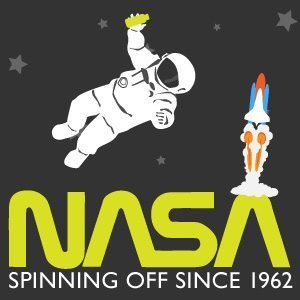NASA
 NASA: Spinning Off Since 1962
NASA: Spinning Off Since 1962
Studies estimate that for every $1 the U.S. government spends on NASA, the economy is boosted by $7-$14. That means that with NASA
NASA: Spinning Off Since 1962
Studies estimate that for every $1 the U.S. government spends on NASA, the economy is boosted by $7-$14. That means that with NASA’s current budget of $17.6 billion, the U.S. economy will get an injection of anywhere from $123.2 billion to $246.4 billion. 1962, NASA established the Technology Utilization Plan (TUP) which makes NASA technologies available to the commercial marketplace. These technologies have led to products, services, and processes that have generated jobs, created profits, and even saved lives.
Spinoffs were such a big hit that in 1976 NASA started a publication called Spinoff which has recorded nearly 1,800 different spinoffs since then.
How Is Technology Spun Off?
NASA considers something a spinoff technology if it meets one of the following scenarios:
NASA develops a technology and sells the license for commercial use.
Example: An Electrolyte Drink
Astronauts have always returned to earth in a dehydrated state. They would try to rehydrate by drinking water and eating salt tablets. After years of extensive testing, a NASA scientist named Dr. John Greenleaf developed and patented a better alternative, an electrolyte concentrate. In 2009, Wellness Brands Inc. bought the exclusive license for theAstronauts have always returned to earth in a dehydrated state. They would try to rehydrate by drinking water and eating salt tablets. After years of extensive testing, a NASA scientist named Dr. John Greenleaf developed and patented a better alternative, an electrolyte concentrate. In 2009, Wellness Brands Inc. bought the exclusive license for the product and named it The Right Stuff.NASA enhances an existing technology and helps grow the industry.
Example: Cloud Computing Software
In 2008, NASA started developing their very own cloud controlling software in order to help standardize their web development. NASA’s work attracted a major player in the industry, Rackspace. Together they created a free and open-source cloud computing platform called Openstack which allows organizations to offer cloud-computing services that run on standard hardware. There are over 200 businesses participating in OpenStack, most notably, IBM, Dell, Pay Pal, AT&T, Intel, Cisco, Yahoo!, Hewlett-Packer, Rackspace, Comcast, and Sony.NASA contracts a company to produce a technology that has future commercial use.
Example: Cordless Tools
Black & Decker created the first cordless tool in 1961. So in the mid-1960’s, NASA contracted Black & Decker to develop a cordless rotary hammer drill to extract rock samples from the surface of the moon. The tool could be used underwater, at zero atmosphere, and in extreme temperatures. Black & Decker used this technology to create the cordless miniature vacuum cleaner, the Dustbuster, as well as several cordless medical tools.ommercial product with the expertise gained from working at NASA.
Example : Kombucha Health Drink
In the 1990’s, Mike Johnson worked at NASA developing technology that converted urine into drinking water by purifying it with microorganisms. Johnson left NASA and used his expertise to develop Unpeeled, a kombucha-based health drink enhanced with probiotics. Whole Foods started selling Unpeeled and helped Johnson sell over 6 million bottles since 2008.
10 Everyday Spinoffs
Water Filter
NASA created the ion purification technology for Apollo. This spinoff created a multimillion dollar industry producing filters for pools, fountains, and drinking water.
Air Purifier
NASA developed an air purifier for astronauts to grow crops in space. Now it’s used by companies like Whole Foods to help preserve food and by hospitals to make their air sanitary. They are used in hotels and homes as well.
Memory Foam
Originally created for more comfortable airline seating, this technology has created a huge industry. The primary use is for mattresses and orthopedic seating.
Computer Mouse NASA invested money in a study that led to the creation of the computer mouse.
Cell Phone Camera
1 out of 3 cell phone cameras use technology developed for space cameras.
Long Distance Communication
NASA’s developments have enhanced the use of satellites for uses like clear long distance communication.
Ear Thermometer
NASA collaborated with Diatek to develop an 8 ounce aural thermometer which uses the same technology used to measure the temperature of stars and planets.
Scratch Resistant Lens
NASA developed a special coating to protect helmet visors and other space equipment from dirt and particles. This technology is used on eye glasses today.
Adjustable Smoke Detector
NASA teamed up with Honeywell Corporation to develop the first adjustable smoke detecto. Innovative Spinoffs
Airplane Winglets
In 1977, NASA, Boeing, and the U.S. Air Force created winglets to reduce drag during flight. By 2010, the technology had saved 2 billion gallons of jet fuel. That’s a savings of $4 billion and 21.5 million tons of carbon dioxide emissions.
Invisible Braces
NASA and Ceradyne develop a translucent material, called TPA, to protect the antennae of heat-seeking missile trackers. A company called Unitek found that NASA’s TPA was the perfect material to make invisible braces.
Text Messaging Plants
AgriHouse Brands Ltd. used technology developed by a partnership of NASA and BioServe Space Technologies to create a leaf sensor that allows “thirsty” plants to text message farmers when they need more water.
Fishing Hotspot Finder
WorldWinds Inc. uses data from NASA satellites that shows water temperature and chlorophyll to predict the most likely spots for catching fish. They have over 8,500 subscribers to the service.
Remote Control Refrigeroven
TMIO Inc. used NASA software to create a smart oven. The appliance refrigerates items until remotely activated to cook them. This item was developed for people who work long hours to be able to eat home cooked meals.